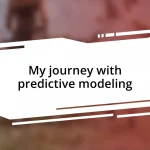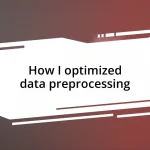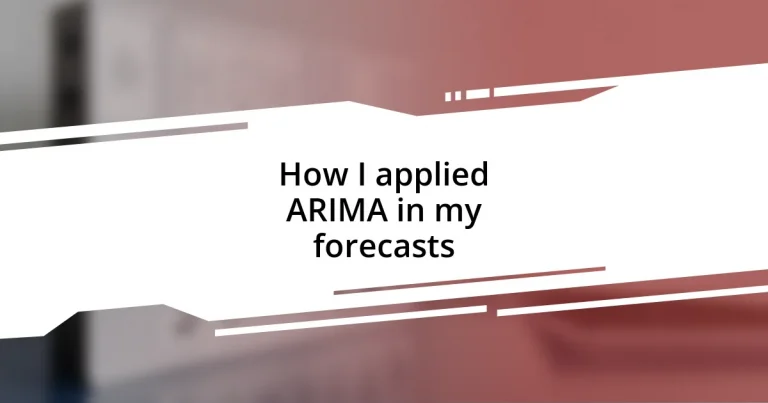Key takeaways:
- ARIMA combines autoregression, differencing, and moving averages, making it effective for time series forecasting.
- Data preparation is crucial; it involves visualizing data, ensuring stationarity, and splitting into training/testing sets to improve model accuracy.
- Selecting ARIMA parameters (p, d, q) and using ACF/PACF plots aids in optimizing forecasts and understanding model dynamics.
- Real-world applications of ARIMA, such as integrating external variables, enhance forecasting insights and strategic planning.
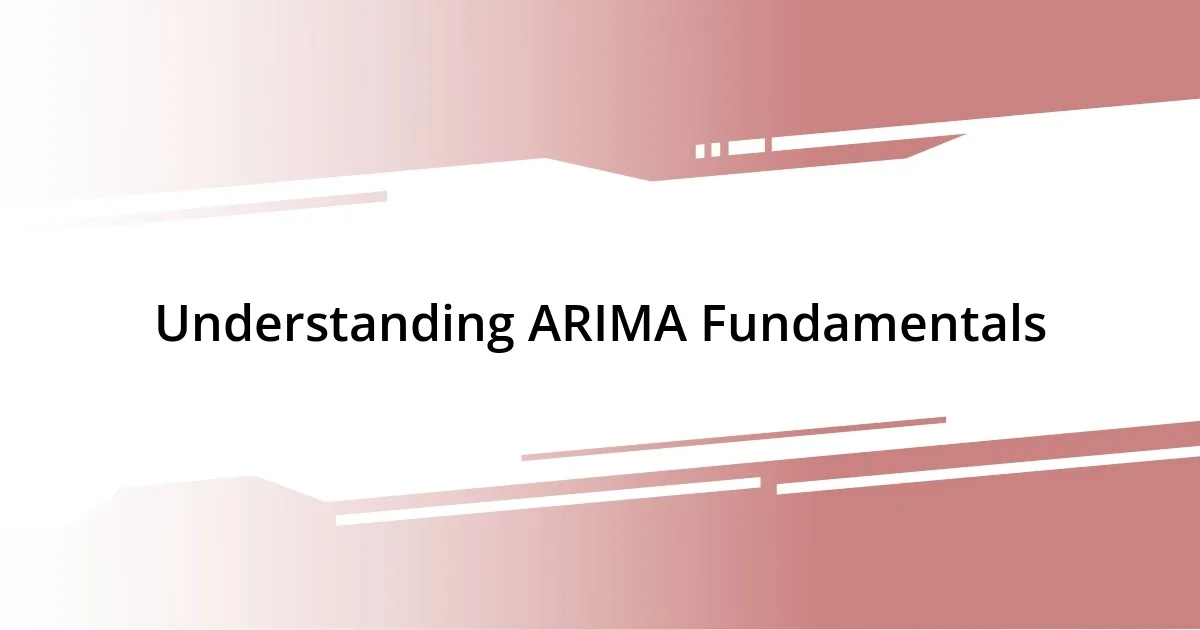
Understanding ARIMA Fundamentals
ARIMA, which stands for AutoRegressive Integrated Moving Average, is a powerful statistical method that’s particularly effective for time series forecasting. When I first encountered ARIMA, I was fascinated by how it combines three key components: autoregression, differencing, and moving averages. I remember thinking, “How can a model, rooted in such complex mathematics, be applied in real-life business scenarios?”
The autoregressive part relies on previous values in the series to predict future values, while the moving average part focuses on past forecast errors to refine predictions. Imagine sitting at your desk, pondering how historical sales data can illuminate your company’s future. It was that moment of clarity for me—the realization that patterns from the past could guide my decisions moving forward.
Differencing is essential in ARIMA as it helps stabilize the mean of the time series by removing trends. I vividly recall working through my first ARIMA model; the thrill of transforming erratic data into a more predictable form was exhilarating. Have you ever felt that rush, knowing you’re taming chaos into clarity? That’s the magic of understanding these fundamentals!
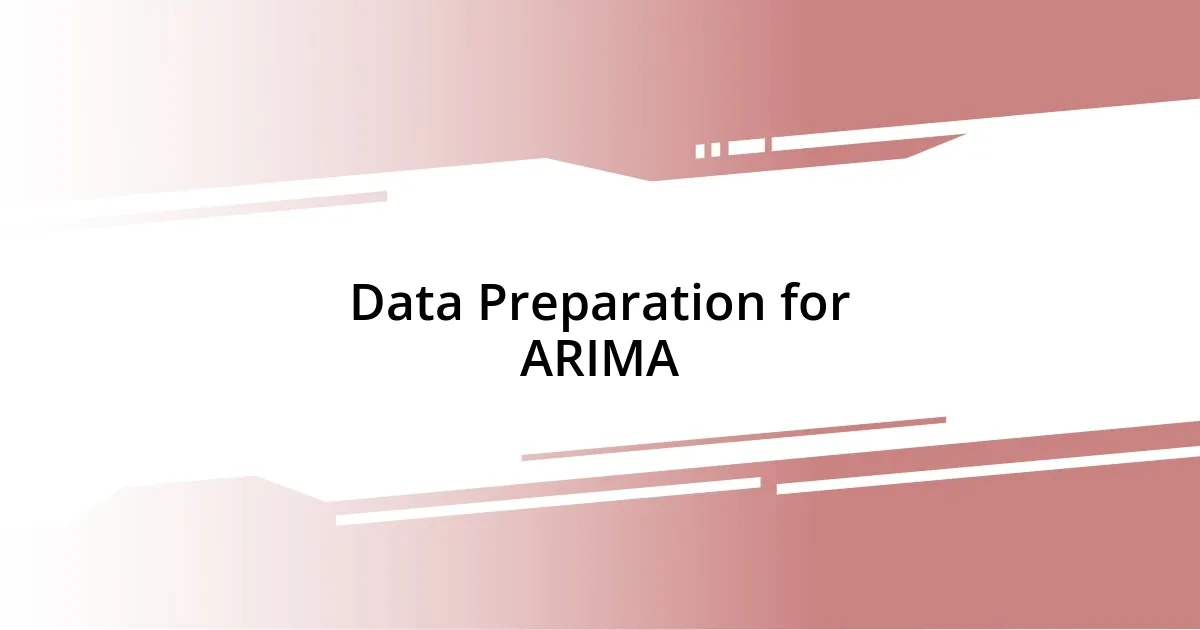
Data Preparation for ARIMA
When it comes to preparing data for ARIMA, the first step I always take is to visualize the time series. This isn’t just about plotting numbers; it’s an emotional experience, almost like watching a story unfold. I recall my first time grappling with spikes and dips on a graph—I could almost feel the tension in the data. Doing this helps me quickly identify any trends, seasonality, or outliers that might impact my forecasts. Getting a clear picture allows me to approach the modeling process with confidence.
Another critical aspect of data preparation is ensuring stationarity. A non-stationary series can produce unreliable forecasts, and I learned this the hard way. I remember feeling defeated when my initial model failed because I hadn’t addressed this issue. Now, I focus on techniques like differencing and transforming data to stabilize the mean and variance. It’s a bit like fine-tuning an instrument; the resulting harmony between data points makes the forecasting so much more accurate.
Lastly, I always split my data into training and testing sets. This step feels like setting the stage for a performance—one where I’ve carefully curated my inputs. I learned that fitting my model on one set and validating it on another grants me insight into how well I can expect my forecasts to perform in the real world. It’s an essential practice that not only builds my confidence but also enhances the model’s reliability.
| Data Preparation Steps | Description |
|---|---|
| Visualization | Plotting the time series helps identify trends, seasonality, and outliers. |
| Stationarity Check | Ensures that the mean and variance remain constant over time, crucial for reliable forecasting. |
| Data Splitting | Dividing data into training and testing sets to validate model performance. |
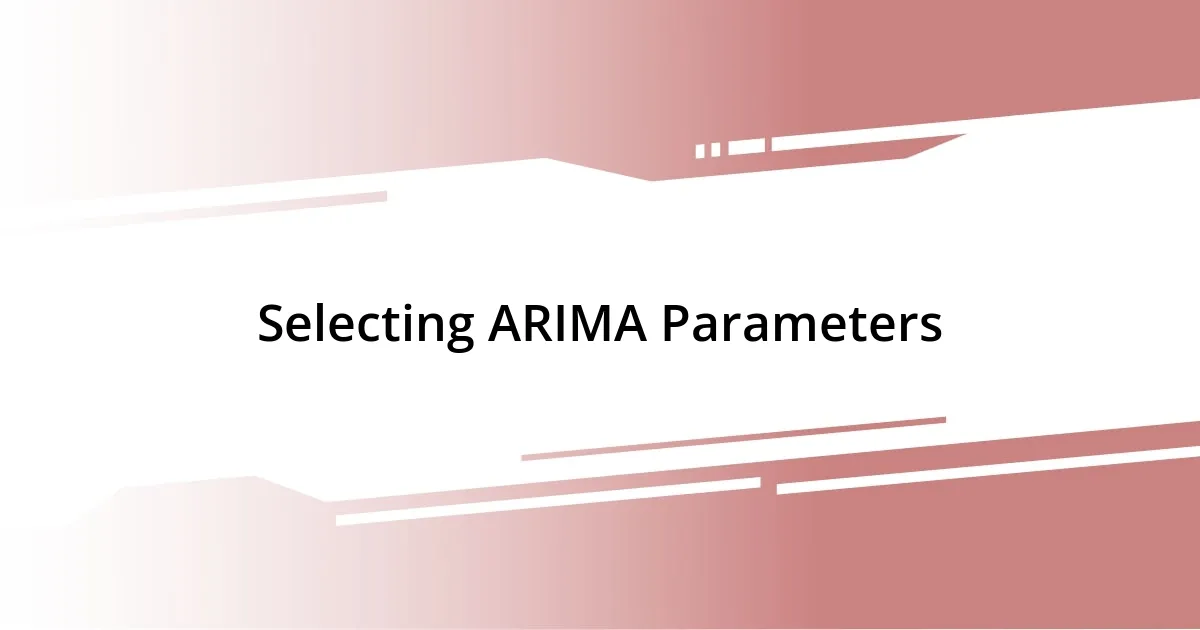
Selecting ARIMA Parameters
Selecting the right parameters for ARIMA is a crucial step that can make or break your forecasting success. Initially, I found this process daunting, but over time, it became almost intuitive. I remember sitting at my desk, eagerly tweaking the parameters and watching how the forecast results shifted like clouds moving across the sky. The parameters—p, d, and q—represent the autoregressive order, the degree of differencing, and the moving average order, respectively.
- p (Autoregressive order): This is how many previous time points we include in the model. A higher p can lead to better fitting but may also cause overfitting.
- d (Differencing): This reflects how many times we need to difference the data to achieve stationarity. It’s essential to determine the right level of differencing, as too much can lose valuable information.
- q (Moving average order): This parameter specifies how many lagged forecast errors are included in the model. A well-chosen q helps fine-tune the forecasts by correcting past errors.
As I selected these parameters, I often relied on techniques like ACF (AutoCorrelation Function) and PACF (Partial AutoCorrelation Function) plots. I can still picture the moment it clicked for me—seeing those plots gave me a new perspective on which parameters to use. It felt like opening a door to a hidden room filled with knowledge, where each spike and dip on the ACF and PACF was a clue guiding me toward the perfect ARIMA model.
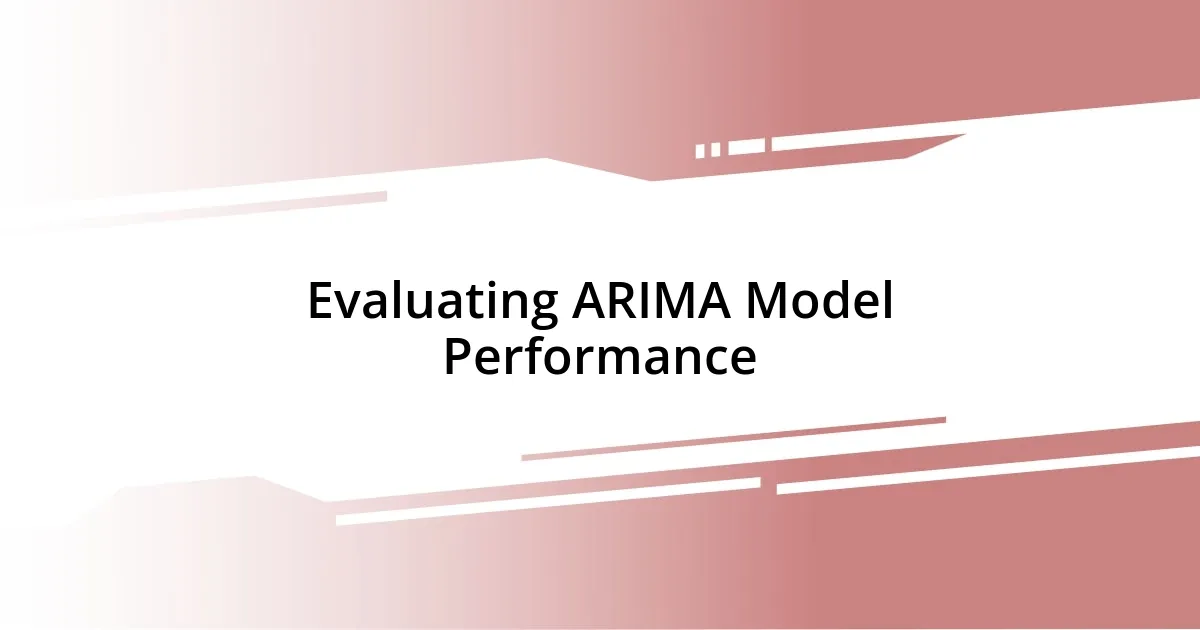
Evaluating ARIMA Model Performance
Evaluating the performance of an ARIMA model is something I take very seriously. One of the key metrics I always look at is the Mean Absolute Error (MAE). When I first calculated it, I felt a mix of anticipation and nervousness, almost like waiting for a report card after a tough exam. MAE provides a straightforward way to understand how far off my forecasts were from actual values, which helps me grasp the model’s accuracy in tangible terms.
Beyond just MAE, I also keep an eye on AIC (Akaike Information Criterion) and BIC (Bayesian Information Criterion). These metrics help me balance the goodness of fit against model complexity. I remember the relief I felt the first time I realized that a model with a lower AIC genuinely indicated a better trade-off. It’s fascinating how these criteria guide me to choose simpler models that don’t sacrifice predictive power, something I didn’t fully appreciate early on in my forecasting journey.
Sometimes, I even resort to visual methods for assessing model performance. Plotting the forecasts against actual data feels like holding a mirror up to my predictions. I distinctly recall the first time I did this; seeing the forecast line dancing along the actual data was thrilling! It was a moment of clarity that reaffirmed the effectiveness of my ARIMA model, making me wonder—how often do we pause to visually celebrate our successes in analytics?
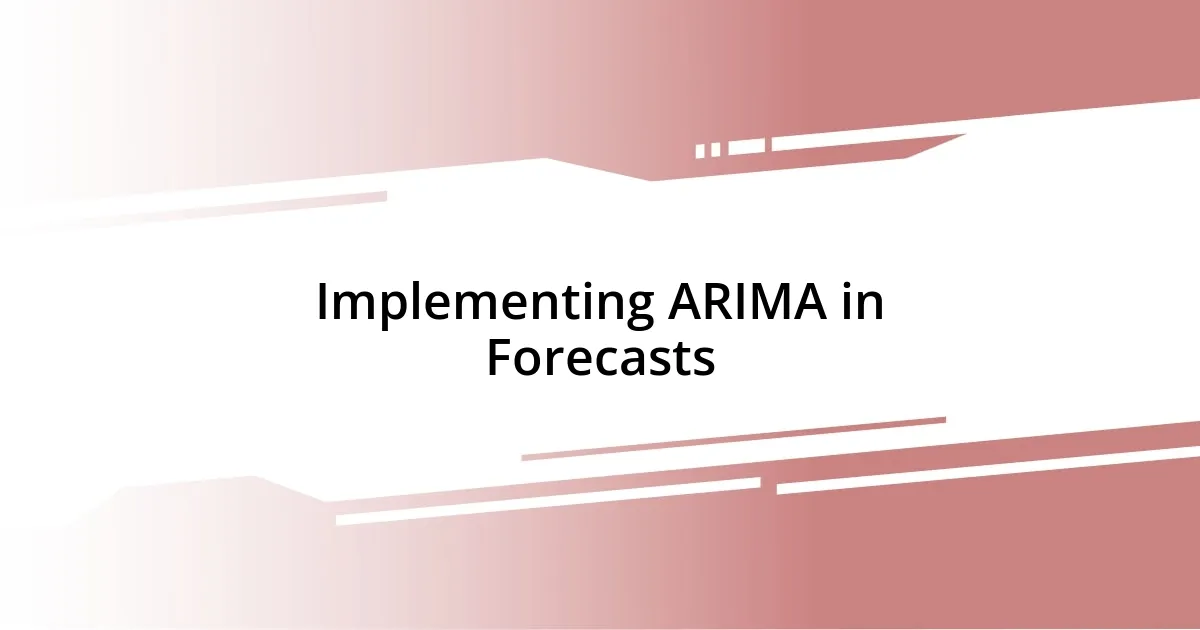
Implementing ARIMA in Forecasts
Implementing ARIMA in forecasts is an exhilarating process that requires careful consideration of the identified parameters. I remember my first attempt at fitting a model; I was both excited and a bit apprehensive, like trying to bake a cake for the first time. I meticulously input the values for p, d, and q based on earlier analyses, but the real thrill came when I expanded my knowledge about seasonal components. I had to ensure that my chosen ARIMA model adequately reflected any underlying seasonality, which added layers to the forecasts that previously seemed straightforward.
Once the model was set up, I dove into the magic of creating forecasts. I can still recall the moment I executed the prediction function for the first time and released a breath I didn’t know I was holding. Watching those lines project into the future felt almost prophetic—like peering into a crystal ball. I was surprised by how quickly I could transfer the output into a visual format, instantly making patterns visible. This is something I’ve come to appreciate deeply; visualization bridges the gap between theory and practicality, helping me see the forecast variations that might inform better decision-making.
As I became more comfortable, I realized that communication of the results is just as critical as the implementation process itself. I vividly remember presenting my forecasts to a small team, feeling a rush of pride and vulnerability at once. The interest and engagement from my colleagues made me aware that sharing insights can spark valuable discussions and even lead to new ideas around the forecasts. How often do we underestimate the power of simply sharing what we’ve learned along the way? Engaging with others not only enriches our understanding but also fosters collaboration—a true win-win in the world of data analytics.
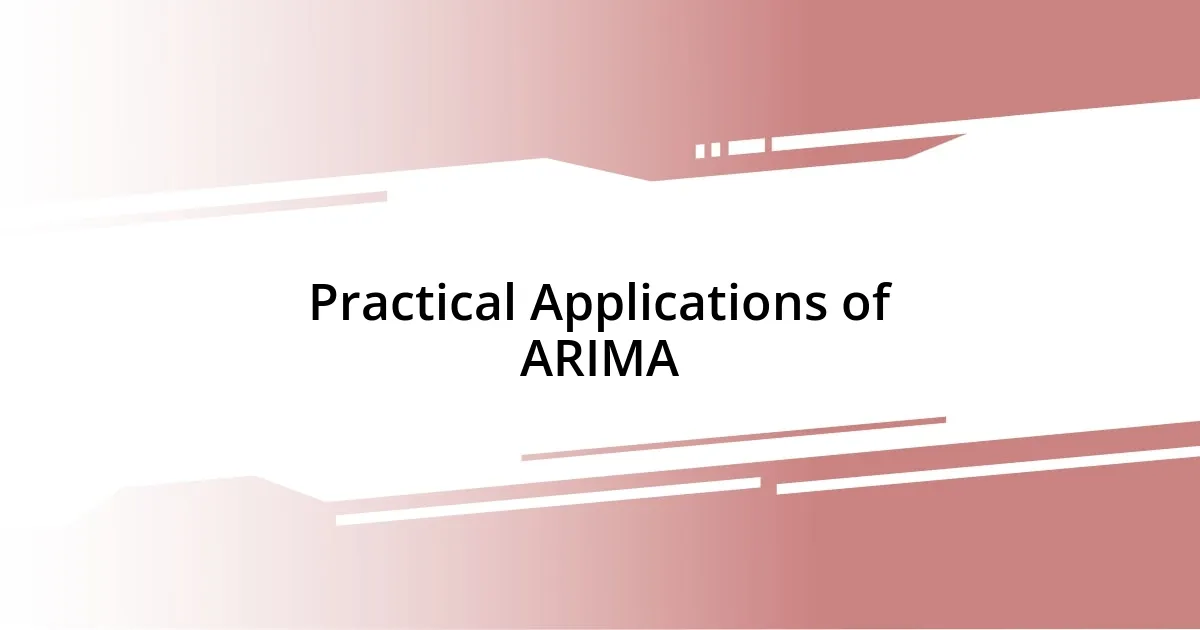
Practical Applications of ARIMA
The beauty of ARIMA shines brightly when applied to real-world scenarios, particularly in sales forecasting. I still remember my excitement when I first applied it to predict monthly sales figures for a retail business. Each forecast revealed trends I hadn’t considered before, igniting a newfound respect for the art of data analysis. It felt like unveiling a hidden timeline, intertwining past performance with future potential.
In employing ARIMA, I learned the importance of preprocessing data. There were times I overlooked this step, thinking I could just plug the raw data into the model. But that was often the moment when my forecasts became less reliable. I vividly recall struggling with inconsistencies that arose from missing values. By taking the time to clean and transform the data, I found that the resulting forecasts were far more aligned with actual outcomes. In effect, investing effort upfront pays off manifold later. Have you ever felt the rush of realization that sometimes the smallest details can lead to the most significant improvements?
Another fascinating application came when I decided to incorporate external variables into my models—this is where ARIMA truly blossomed. I experimented with adding economic indicators to the forecasts, which enriched my insights. I recall presenting these findings to my boss, feeling a mix of nerves and anticipation, only to be met with enthusiasm when the correlation became clear. The ability to marry time series data with external factors opened up expansive avenues for strategic planning, captivating stakeholders and stimulating fresh conversations. It’s intriguing how layering additional elements into ARIMA can transform mere numbers into a story that resonates with the overarching business narrative.

Troubleshooting Common ARIMA Issues
When I first dove into ARIMA, I encountered a common issue: the model didn’t always converge. It was frustrating! There were days when I felt like I was chasing my own tail, trying to figure out if the parameters I set were too optimistic. I learned that tweaking p, d, and q isn’t just a mechanical task; it demands a blend of intuition and testing. Do you remember a time when adjusting a single value made all the difference? In my case, a simple adjustment led to smoother convergence and more reliable forecasts.
Another hiccup I faced was diagnosing non-stationarity in my time series data. I thought I could just eye the plot and move on, but that was a naive approach. It took me a couple of failed attempts before I fully grasped the necessity of performing tests like the Augmented Dickey-Fuller test. After finally applying a differencing technique, I can vividly recall that sense of relief washing over me when the data finally revealed a clear, stationarized pattern. It made me wonder: how many forecasters miss this crucial step and end up with misguided results?
Lastly, I often grappled with overfitting my models. Initially, I aimed for the most complex ARIMA configurations, convinced that more parameters would equal better forecasts. But as I soon realized, simplicity often trumps complexity. One time, I stripped down my model, reducing it to its essentials, and to my surprise, the forecasts became more accurate. Have you ever discovered that sometimes, less really is more? It was a pivotal learning moment, reinforcing the importance of balance and the careful consideration of model complexity in my forecasting journey.




